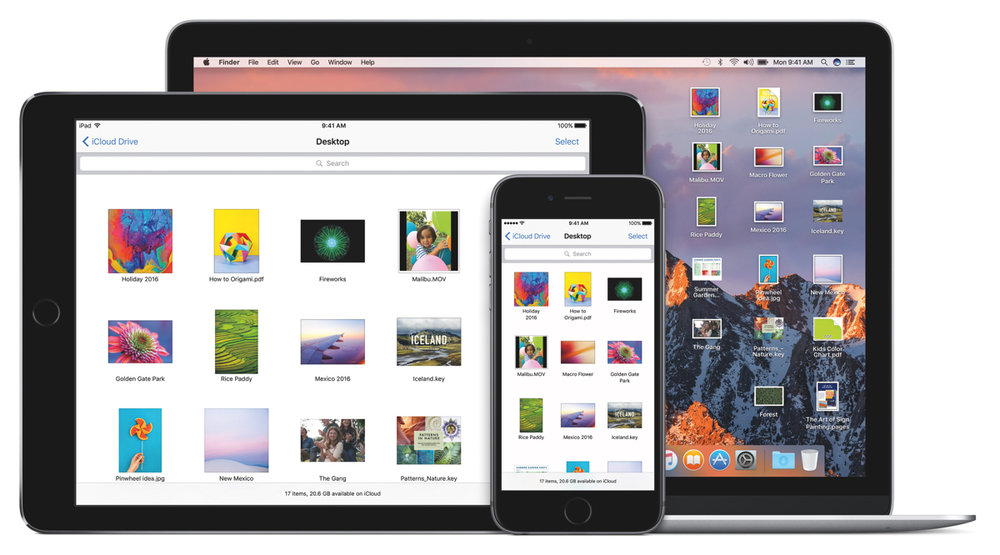Apple has released a finished version of macOS X Sierra. It’s a free download at the Mac App Store. Sierra requires a 2009 iMac, 2009 MacBook, 2010 MacBook Air, MacBook Pro, Mac mini, or Mac Pro.
Siri is now on the Mac. Users can look up information, find documents, pin or drag and drop search results, and even adjust system preferences. Integration with iCloud makes everything from your Desktop and Documents folder available on your iPhone and iPad so you always have access to the files you need.

The new Universal Clipboard feature allows you to copy content, including text, images, photos and video from one Apple device and paste it in another. Apple Pay comes to the Mac in Sierra so it’s even easier to shop securely and privately online, according to Craig Federighi, Apple’s senior vice president of Software Engineering (who, in my humble opinion, is Apple’s best presenter at these events).
Accessible from the Dock, menu bar or keyboard, Siri lets you use your voice to search for information, find files and send messages. For example, you can ask the personal digital assistant to locate a specific document you worked on last night, add a meeting to your calendar or start a FaceTime call.
With Siri on the Mac, you can also drag and drop items from Siri search results into your documents or emails, pin Siri search results in Notification Center to keep an eye on information like sports scores or stock prices, and even adjust system preferences, set reminders and search your Photos library.
With macOS Sierra you can automatically have all the files on your Desktop and in your Documents folder on any Mac, iOS device — or even a PC (if you must). You simply save your files on your Desktop or within your Documents folder as you usually do and you will have them everywhere you need them. You can access your files on your iPhone and iPad in the iCloud Drive app and on iCloud.com or the iCloud for Windows app. And when you log into a second Mac, your files are automatically on the Desktop and in the Documents folder, exactly where you saved them.
Continuity across your Apple devices also gets better in macOS Sierra, says Federighi. With Universal Clipboard, the contents of your clipboard are available across all your Apple devices via iCloud. You can copy and paste text, images, photos and video between your Mac and your iPhone and iPad.
To help you navigate your Desktop with more efficiency, macOS Sierra takes the Tabs feature from Safari and makes it available across Mac apps that support multiple windows, including Maps, Mail, Pages, Numbers, Keynote and TextEdit, and even third-party apps. With Tabs you can browse multiple locations in Maps without losing your place, copy and paste between Pages documents in full screen, or quickly jump between multiple email drafts in Mail.
macOS Sierra also adds the picture-in-picture feature introduced with iOS 9. It lets you “float” video from Safari or iTunes in a window over your desktop as you work, and even resize, drag and pin video to any corner of your screen. The video stays put when you switch spaces.

macOS Sierra also adds Apple Pay on the web, which is designed to make it easy to make secure and private purchases when shopping on participating websites. You no longer need to share credit or debit card numbers with an online merchant and actual card numbers aren’t stored on your device, nor on Apple servers. Just look for the Apple Pay button at checkout on many of your favorite shopping sites and complete your purchase with Touch ID on your iPhone or by using your Apple Watch. Strong encryption protects all communication between your devices and Apple Pay servers, and Apple Pay doesn’t track your purchases.
The new Memories feature in Photos helps you rediscover favorite and forgotten moments deep in your Photos library by automatically creating curated collections of occasions like a first birthday party, wedding or family vacation. With new advanced computer vision, Photos now understands the people, places and things inside your images using on-device facial, object and scene recognition and location information to group images into albums, says Federighi.
The People feature automatically groups your photos into Albums based on who is in them. Places now displays your photos on a world map so you can see where they were taken. The new Brilliance tool pulls in highlights and adds contrast to enhance details throughout your images.
And there’s more. Auto Unlock lets you simply walk up to your Mac while wearing your authenticated Apple Watch and be automatically logged into your desktop. Optimized Storage frees up space when your Mac starts getting full by storing infrequently used items in iCloud and reminding you to delete used app installers, and even clearing out duplicate downloads, caches, logs and more.
Messages now allows you to preview web links and watch video clips within the app, post reactions like a heart, thumbs up and more directly onto a message bubble with Tapback, and use bigger emoji for more message impact. Apple Music in iTunes makes it even easier to discover new music and browse exclusives and new releases.
iMessage and FaceTime use end-to-end encryption to protect your data by making it unreadable by Apple and others, says Federighi. Services like Siri and Maps send data to Apple’s servers, but this data is not used to build user profiles, and Photos uses on-device intelligence to organize your images using facial, object and scene recognition.
Starting with macOS Sierra, Apple is using technology called Differential Privacy to help discover the usage patterns of a large number of users without compromising individual privacy. In macOS Sierra, this technology will help improve autocorrect suggestions and Lookup Hints in Notes.

